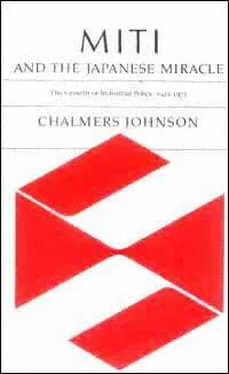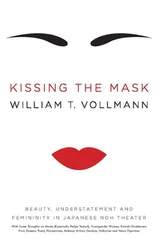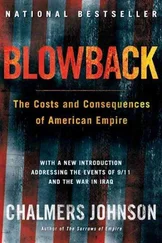Chalmers Johnson - MITI and the Japanese miracle
Здесь есть возможность читать онлайн «Chalmers Johnson - MITI and the Japanese miracle» весь текст электронной книги совершенно бесплатно (целиком полную версию без сокращений). В некоторых случаях можно слушать аудио, скачать через торрент в формате fb2 и присутствует краткое содержание. Год выпуска: 2007, Издательство: Stanford University Press, Жанр: Старинная литература, на английском языке. Описание произведения, (предисловие) а так же отзывы посетителей доступны на портале библиотеки ЛибКат.
- Название:MITI and the Japanese miracle
- Автор:
- Издательство:Stanford University Press
- Жанр:
- Год:2007
- ISBN:нет данных
- Рейтинг книги:3 / 5. Голосов: 1
-
Избранное:Добавить в избранное
- Отзывы:
-
Ваша оценка:
- 60
- 1
- 2
- 3
- 4
- 5
MITI and the Japanese miracle: краткое содержание, описание и аннотация
Предлагаем к чтению аннотацию, описание, краткое содержание или предисловие (зависит от того, что написал сам автор книги «MITI and the Japanese miracle»). Если вы не нашли необходимую информацию о книге — напишите в комментариях, мы постараемся отыскать её.
MITI and the Japanese miracle — читать онлайн бесплатно полную книгу (весь текст) целиком
Ниже представлен текст книги, разбитый по страницам. Система сохранения места последней прочитанной страницы, позволяет с удобством читать онлайн бесплатно книгу «MITI and the Japanese miracle», без необходимости каждый раз заново искать на чём Вы остановились. Поставьте закладку, и сможете в любой момент перейти на страницу, на которой закончили чтение.
Интервал:
Закладка:
23
But in order to make Kishi effective, although Tojo was the formal minister, Tojo had to adopt an expedient that ultimately made his own political problems worse. He appointed Kishi both vice-minister of munitions and state minister with cabinet rank (
gunju jikan kokumu daijin
), thus making him the de facto head of MM.
Kishi himself has commented on this strange arrangement, as have numerous outside observers. Kishi says that he told Tojo that as vice-minister he would have to obey Tojo as his minister and superior, but that as minister of state he did not have to obey him because they would both have equivalent ranks. Tojo certainly understood this point, but he appointed Kishi state minister anyway in order to give him sufficient authority to command the generals and admirals who would be working in Kishi's ministry. Tojo remarked to Kishi that military men are trained to take orders according to the number of stars a person wears; a vice-minister has only two stars, but a minister has three.
24
Kishi's becoming minister and vice-minister simultaneously set up and conditioned his clash with Tojo less than a year later. This clash was of much greater significance historically than Kishi's earlier ones (over the pay cuts and with ministers Ogawa and Kobayashi), and it contributed one of Kishi's nicknames, the "quarreler" (
kenka
), and added to his reputation as a man of principle.
25
Trouble between Tojo and Kishi began almost at once. The secret appointment of Fujihara as Kishi's watchdog barely three weeks after the new ministry had been launched caused Kishi to tender his resignation. He argued that it was hard enough to run MM with two ministers; three was impossible. Tojo refused to accept his resignation, accused Kishi of being irresponsible, and said that Fujihara was necessary to keep the zaibatsu quiet. However, six months later, in July 1944, Tojo asked for Kishi's resignation, and this time Kishi refused to give it, citing his independent responsibility as a minister to the throne. This impasse could not be resolved, and the Tojo government fell.
The ostensible cause of the resignation of the Tojo cabinet was the American capture of Saipan. Kishi forthrightly expressed his opinion that Japan had no chance of winning after Saipan and should there-
Page 171
fore sue for peace. Tojo * was enraged. The word "defeat" was all but taboo in the Japan of 1944, and Tojo accused Kishi of meddling with the military's prerogative of supreme command. This was an extremely dangerous charge for Kishi. Tojo exercised effective control over the military police (
kempeitai
)he was a former Kempei commander in the Kwantung Armyand he had caused several political figures to meet their deaths at the hands of the military police for disagreeing with him (for example, Nakano Seigo*, 18861943, a member of the Diet since 1920).
Kishi nonetheless stood his ground. The inner reality was that powerful figures in the Diet and the Imperial Household agreed with Kishi and wanted to be rid of Tojo. Some of these men were Kido Koichi* (in the palace); Funada Naka (in the Diet); Ino Hiroya (an old MAC associate of Kishi's and one whom Kishi wished had gone to MCI instead of Agriculture in 1925; he served from 1941 to 1943 in the Tojo cabinet as agriculture minister); and Fujiyama Aiichiro* (a prominent businessman and adviser to the navy who plotted with the admirals against Tojo after the Saipan disaster). It appears that Tojo did not dare move against Kishi because he feared Kishi's numerous but unseen supporters. Incidentally, after Kishi became prime minister in 1957, he named Fujiyama minister of foreign affairs in his first cabinet and Ino minister of justice in his second.
The cabinet of General Koiso, who succeeded Tojo, was transitional. The "watchdog" Fujihara moved up to become minister of munitions, and he appointed Kishi's old bureaucratic competitor, Takeuchi Kakichi (one of Murase Naokai's associates), as vice-minister. Fujihara only lasted six months. He resigned at the end of 1944 because of "ill health" (he was 75 years old but lived on until 1960); the real reason, however, was that a Mitsubishi-Sumitomo coalition forced him out because they were worried that a Mitsui-affiliated minister might threaten their own interests. As a replacement the prime minister chose a neutral figurethe old Home Ministry bureaucrat and first director of the Cabinet Research Bureau back in 1935, Yoshida Shigeru.
*
In the spring of 1945 the fall of Iwo Jima, the invasion of Okinawa, and the great March 10 air raid on Tokyo precipitated the resignation of the Koiso cabinet. The new government of Admiral Suzuki was charged to bring the war to an end, which it did. For his munitions minister, Suzuki chose a fellow admiral, the ubiquitous Toyoda Teijiro*, who was then working as head of the Iron and Steel Control


*
Again it should be remembered that this is not the Yoshida Shigeru who became prime minister after the war.
Page 172
Association. Toyoda, in turn, appointed Shiina Etsusaburo * as vice-minister, the same position Shiina had held in MCI before it became MM. It was Shiina who actually presided over his ministry's end-of-the-war arrangements, and in retrospect he must be given credit for taking quick action at a time of major confusion.
On August 15, 1945, the nation heard the
gyokuon
hoso
*the Emperor's broadcast announcing the surrender. Two days later the Suzuki cabinet resigned and was replaced by the transitional government of Prince Higashikuni. Nakajima Chikuhei, the famous aircraft industrialist, was asked to hold the portfolio for MM, which ironically put Nakajima back in nominal control of the aircraft plants that had been taken from him and nationalized only the previous June. Shiina, however, continued to run the ministry. Only ten days after the fighting stopped and barely a day before the first Allied troops arrived at Atsugi air base to prepare the way for General MacArthur, Shiina told several of his younger colleagues that he had an important assignment for them, one that they must complete overnight. They were to recreate MCI before the occupation began.
Yamamoto Takayuki, MITI's first vice-minister in 1949, has said that the overnight rebirth of MCI was ordered because all the civilian bureaucrats in MM feared that the Allies would fire or arrest anyone connected with munitions. Shiina has indicated that he also had personal reasons for wanting to put some distance between the MCI contingent and the military officers in MM, and that he recognized the necessity for getting rid of the Munitions Ministry before the Americans did so. According to various accounts, those involved in the resurrection were Yamamoto, Ueno Koshichi*, Tokunaga Hisatsugu, and Hirai Tomisaburo*, all of whom became MITI vice-ministers during the 1950's.
26
Thus, by Imperial ordinance 486 of August 26, 1945, the Ministry of Munitions and the Ministry of Agriculture and Commerce disappeared, and in their places were reinstalled the old MCI and the old Ministry of Agriculture and Forestry.
Shortly after the establishment of SCAP headquarters, Allied investigators discovered the end-of-the-war juggling of ministries, but they did not attempt to do anything about it because the changes had been in the direction the Allies wanted the Japanese to go anyway. One of the official, although nameless, American historians of the occupation merely noted, "Bureaucrats were aware that their presurrender cooperation with militarists and zaibatsu interests constituted a threat to their continued hegemony. In the weeks before the occupation began officially, personnel records were destroyed, wholesale shifts of higher officials were made, and initial steps were taken to
Читать дальшеИнтервал:
Закладка:
Похожие книги на «MITI and the Japanese miracle»
Представляем Вашему вниманию похожие книги на «MITI and the Japanese miracle» списком для выбора. Мы отобрали схожую по названию и смыслу литературу в надежде предоставить читателям больше вариантов отыскать новые, интересные, ещё непрочитанные произведения.
Обсуждение, отзывы о книге «MITI and the Japanese miracle» и просто собственные мнения читателей. Оставьте ваши комментарии, напишите, что Вы думаете о произведении, его смысле или главных героях. Укажите что конкретно понравилось, а что нет, и почему Вы так считаете.












